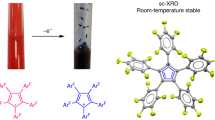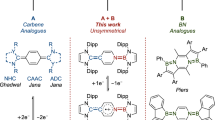Abstract
The discovery in 1900 by Gomberg that the trityl radical (Ph3C·) exists at room temperature is often considered to be the beginning of radical chemistry. Since then, persistent and even room-temperature stable radicals based on second-row and heavier elements have been synthesized. However, few of them have been characterized crystallographically, because they are either too reactive or dimerize in the solid state. Here, we show that a P2 fragment, capped with two bulky, strongly electron-releasing singlet carbenes (dicoordinate carbon compounds with only six valence electrons), can undergo one-electron oxidation, giving rise to room-temperature stable radical cations. Moreover, when N-heterocyclic carbenes are used, two-electron oxidation can also be performed, producing the corresponding stable dicationic diphosphene, which has to be regarded as a P22+ fragment coordinated by two carbenes. These results reveal a new application of stable singlet carbenes, the stabilization of paramagnetic species and electron-poor fragments.
This is a preview of subscription content, access via your institution
Access options
Subscribe to this journal
Receive 12 print issues and online access
$259.00 per year
only $21.58 per issue
Buy this article
- Purchase on Springer Link
- Instant access to full article PDF
Prices may be subject to local taxes which are calculated during checkout



Similar content being viewed by others
References
Igau, A., Baceiredo, A., Trinquier, G. & Bertrand, G. [Bis(diisopropylamino) phosphino](trimethylsilyl)carbene; a stable nucleophilic carbene. Angew. Chem. Int. Ed. Engl. 28, 621–622 (1989)
Arduengo, A. J. III Harlow, R. L. & Kline, M. A stable crystalline carbene. J. Am. Chem. Soc. 113, 361–363 (1991).
Enders, D., Niemeier, O. & Henseler, A. Organocatalysis by N-heterocyclic carbenes. Chem. Rev. 107, 5606–5655 (2007).
Marion, N., Diez-Gonzalez, S. & Nolan, S. P. N-heterocyclic carbenes as organocatalysts. Angew. Chem. Int. Ed. 46, 2988–3000 (2007).
Kamber, N. E. et al. N-heterocyclic carbenes: effective organic catalysts for living polymerization. Chem. Rev. 107, 5813–5840 (2007).
Frey, G. D., Lavallo, V., Donnadieu, B., Schoeller, W. W. & Bertrand, G. Facile splitting of hydrogen and ammonia by nucleophilic activation at a single carbon center. Science 316, 439–441 (2007).
Masuda, J. D., Schoeller, W. W., Donnadieu, B. & Bertrand, G. NHC-mediated aggregation of P4: isolation of a P12 cluster. J. Am. Chem. Soc. 129, 14180–14181 (2007).
Masuda, J. D., Schoeller, W. W., Donnadieu, B. & Bertrand, G. Carbene activation of P4 and subsequent derivatization. Angew. Chem. Int. Ed. 46, 7052–7055 (2007).
Díez-González, S., Marion, N. & Nolan, S. P. N-heterocyclic carbenes in late transition metal catalysis. Chem. Rev. 109, 3612–3676 (2009).
Lin, J. C. Y. et al. Coinage metal−N-heterocyclic carbene complexes. Chem. Rev. 109, 3561–3598 (2009).
Samojłowicz, C., Bieniek, M. & Grela, K. Ruthenium-based olefin metathesis catalysts bearing N-heterocyclic carbene ligands. Chem. Rev. 109, 3708–3742 (2009).
Grubbs, R. H. Olefin metathesis. Tetrahedron 60, 7117–7140 (2004).
Dyker, C. A., Lavallo, V., Donnadieu, B. & Bertrand, G. Synthesis of a strongly bent acyclic allene (a ‘carbodicarbene’): a novel type of strong donor ligand. Angew. Chem. Int. Ed. 47, 3206–3209 (2008).
Wang, Y. Z. et al. A stable silicon(0) compound with a Si=Si double bond. Science 321, 1069–1071 (2008).
Dyker, C. A. & Bertrand, G. Soluble allotropes of main group elements. Science 321, 1050–1051 (2008).
Tonner, R. & Frenking, G. C(NHC)2: divalent carbon(0) compounds with N-heterocyclic carbene ligands—theoretical evidence for a class of molecules with promising chemical properties. Angew. Chem. Int. Ed. 46, 8695–8698 (2007).
Alcarazo. M., Lehmann, C. W., Anoop, A., Thiel, W. & Fürstner, A. Coordination chemistry at carbon. Nature Chem. 1, 295–301 (2009).
Wang, Y. Z. et al. Carbene-stabilized diphosphorus. J. Am. Chem. Soc. 130, 14970–14971 (2008).
Back, O., Kuchenbeiser, G., Donnadieu, B. & Bertrand, G. Non-metal mediated fragmentation of P4. Isolation of P1 and P2 bis-carbene adducts. Angew. Chem. Int. Ed. 48, 5530–5533 (2009).
Hahn, F. E. & Jahnke, M. C. Heterocyclic carbenes: synthesis and coordination chemistry. Angew. Chem. Int. Ed. 47, 3122–3172 (2008).
Arduengo, A. J. III. Looking for stable carbenes: the difficulty in starting anew. Acc. Chem. Res. 32, 913–921 (1999).
Lavallo, V., Canac, Y., Prasang, C., Donnadieu, B. & Bertrand, G. Stable cyclic (alkyl)(amino)carbenes as rigid or flexible, bulky, electron-rich ligands for transition metal catalysts: a quaternary carbon makes the difference! Angew. Chem. Int. Ed. 44, 5705–5709 (2005).
Zeng, X., Frey, G. D., Kinjo, R., Donnadieu, B. & Bertrand, G. Synthesis of a simplified version of stable bulky and rigid cyclic (alkyl)(amino)carbenes (CAACs), and catalytic activity of the ensuing gold(I) complex in the three-component preparation of 1,2-dihydroquinoline derivatives. J. Am. Chem. Soc. 131, 8690–8696 (2009).
Tumanskii, B., Sheberla, D., Molev, G. & Apeloig, Y. Dual character of Arduengo carbene–radical adducts: addition versus coordination product. Angew. Chem. Int. Ed. 46, 7408–7411 (2007).
Ueng, S. H. et al. N-heterocyclic carbene boryl radicals: a new class of boron-centered radical. J. Am. Chem. Soc. 131, 11256–11262 (2009).
Matsumoto, T. & Gabbai, F. P. A borenium cation stabilized by an N-heterocyclic carbene ligand. Organometallics 28, 4252–4253 (2009).
Loss, S. et al. Isolation of a highly persistent diphosphanyl radical: the phosphorus analogue of a hydrazyl. Angew. Chem. Int. Ed. 40, 723–726 (2001).
Power, P. P. Persistent and stable radicals of the heavier main group elements and related species. Chem. Rev. 103, 789–809 (2003).
Armstrong, A., Chivers, T. & Boere, R. T. The diversity of stable and persistent phosphorus-containing radicals. ACS Symposium Ser. 917, 66–80 (2006).
Marque, S. & Tordo, P. Reactivity of phosphorus centered radicals. Top. Curr. Chem. 250, 43–76 (2005).
Scheer, M. et al. The complexed triphosphaallyl radical, cation, and anion family. Angew. Chem. Int. Ed. 48, 2600–2604 (2009).
Ito, S. et al. Preparation and characterization of an air-tolerant 1,3-diphosphacyclobuten-4-yl radical. Angew. Chem. Int. Ed. 45, 4341–4345 (2006).
Agarwal, P., Piro, N. A., Meyer, K., Muller, P. & Cummins, C. C. An isolable and monomeric phosphorus radical that is resonance-stabilized by the vanadium(iv/v) redox couple. Angew. Chem. Int. Ed. 46, 3111–3114 (2007).
Hinchley, S. L. et al. Spontaneous generation of stable pnictinyl radicals from ‘jack-in-the-box’ dipnictines: a solid-state, gas-phase, and theoretical investigation of the origins of steric stabilization. J. Am. Chem. Soc. 123, 9045–9053 (2001).
Sasamori, T. et al. One-electron reduction of kinetically stabilized dipnictenes: synthesis of dipnictene anion radicals. J. Am. Chem. Soc. 128, 12582–12588 (2006).
Geoffroy, M., Jouaiti, A., Terron, G. & Cattani-Lorente, M. Phosphaalkene radical anions: electrochemical generation, ab initio predictions, and ESR study. J. Phys. Chem. 96, 8241–8245 (1992).
Power, P. P. Pi-bonding and the lone pair effect in multiple bonds between heavier main group elements. Chem. Rev. 99, 3463–3503 (1999).
Sasamori, T. & Tokitoh, N. Doubly bonded systems between heavier Group 15 elements. Dalton Trans. 1395–1408 (2008).
Lavallo, V., Canac, Y., Donnadieu, B., Schoeller, W. W. & Bertrand, G. CO fixation to stable acyclic and cyclic alkyl amino carbenes: stable amino ketenes with a small HOMO–LUMO gap. Angew. Chem. Int. Ed. 45, 3488–3491 (2006).
Zhao, Y., Schultz, N. E. & Truhlar, D. G. Design of density functionals by combining the method of constraint satisfaction with parametrization for thermochemistry, thermochemical kinetics, and noncovalent interactions. J. Chem. Theory Comput. 2, 364–382 (2006).
Schafer, A., Horn, H. & Ahlrichs, R. Fully optimized contracted Gaussian basis sets for atoms Li to Kr. J. Chem. Phys. 97, 2571–2577 (1992).
Frisch, M. J. et al. Gaussian 03, Revision E.01 (Gaussian, 2004).
Reed, A. E., Curtiss, L. A. & Weinhold, F. Intermolecular interactions from a natural bond orbital, donor–acceptor viewpoint. Chem. Rev. 88, 899–926 (1988).
Acknowledgements
The authors gratefully acknowledge financial support from the National Science Foundation (CHE-0924410), the Alexander von Humboldt Foundation (fellowship to P.P.) and Deutsche Forschungsgemeinschaft. Thanks are also given to D. Borchardt for the EPR part of this paper.
Author information
Authors and Affiliations
Contributions
O.B. performed the chemical experiments, B.D. performed the X-ray diffraction studies, and P.P. carried out the calculations. G.F. and G.B. co-wrote the paper. All authors discussed the results and commented on the manuscript.
Corresponding author
Ethics declarations
Competing interests
The authors declare no competing financial interests.
Supplementary information
Supplementary information
Supplementary information (PDF 501 kb)
Supplementary information
Crystallographic data for the radical cation of compound 2 (CIF 32 kb)
Supplementary information
Crystallographic data for the radical cation of compound 4 (CIF 38 kb)
Supplementary information
Crystallographic data for the dication of compound 4 (CIF 20 kb)
Rights and permissions
About this article
Cite this article
Back, O., Donnadieu, B., Parameswaran, P. et al. Isolation of crystalline carbene-stabilized P2-radical cations and P2-dications. Nature Chem 2, 369–373 (2010). https://doi.org/10.1038/nchem.617
Received:
Accepted:
Published:
Issue Date:
DOI: https://doi.org/10.1038/nchem.617
This article is cited by
-
A bis(silylene)-stabilized diphosphorus compound and its reactivity as a monophosphorus anion transfer reagent
Nature Chemistry (2020)
-
From stable Sb- and Bi-centered radicals to a compound with a Ga=Sb double bond
Nature Communications (2018)
-
Highly durable organic electrode for sodium-ion batteries via a stabilized α-C radical intermediate
Nature Communications (2016)
-
A coordination chemistry dichotomy for icosahedral carborane-based ligands
Nature Chemistry (2011)



